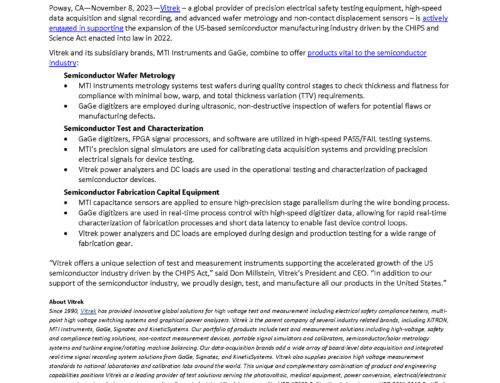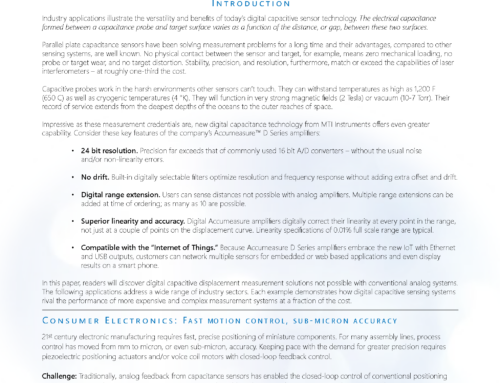This application note from MTI Instruments compares two technologies for measuring foam density: capacitance sensors and nuclear gauges. It examines the basic operating principles of each technology and explains why capacitance measurement is recommended for in-line measurement during foam manufacturing.
Capacitance Sensors
Capacitive probes are non-contact devices that use electric fields to measure foam density. In combination with a thickness value, a density measurement may be calculated. These probes consist of a capacitance sensor inside of a protective housing and are part of a larger measurement system that includes amplifiers, cables, and software. With parallel plate capacitance, the capacitance probe is one of the plates and a grounded plate is the other. Because the target is grounded, non-conductive matecapacitancerials such as foams can be measured when they are inserted between the capacitance probe and the grounded plate. This is because the foam is a dielectric material and changes the capacitance value of the gap between the probe and the grounded plate. The change is proportional to the foam thickness and its density as related by the Clausius-Mossotti equation:
The equation looks challenging, but simply put, if you know the thickness of the foam, you’ll know the density of the foam by also measuring the capacitance change of the gap. As Figure 1 below shows, the probe’s sensing element measures this change without touching the non-conductive material.
Capacitive systems work by measuring the impedance of the gap. This is directly proportional to the capacitance of the gap and the dielectric constant of any material in the gap. Figure 2 shows how capacitance decreases as reactive impedance increases.
MTI’s Digital Accumeasure capacitive system does not require extensive calibration but materials with higher dielectric constants are better at conducting the electric field. MTI’s Digital Accumeasure, a system that uses a microprocessor and a digital capacitance sensor, makes fast, accurate, non-contact measurements as foam materials are moving along a conveyor.
Capacitance is directly proportional to the density of foam if the thickness of this non-conductive material is known or can be simultaneously measured as with laser sensors. Although the relationship between these variables is somewhat complex, capacitive measurement requires a simple calibration procedure rather than an intricate mathematical calculation. The dielectric constant of a material, a measure of its ability to transmit electrical potential energy, is important here. As long as the dielectric constant of the material doesn’t change, the calibration will remain consistent.
Nuclear Gauges
Traditionally, nuclear gauges have also been used to measure density of materials such as foam. These devices use radioactive sources to measure foam density. The basic components of these systems include a nuclear source, detector, shutter, shutter control, shielding, and retractable rod. Depending on the application requirements, the nuclear source can be gamma, beta, or neutron radiation. During device operation, detector tubes in the nuclear gauge’s base count the number of emitted photons that are received over a given period of time, typically 60 seconds.
Nuclear gauges are fast, accurate, and come in both fixed and portable configurations. Although they do not expose operators to high levels of radiation, safety concerns remain because radiation is harmful to the environment and to the human body. Periodically, devices must be tested for radioactive leaks. There are security concerns as well. Consequently, portable devices must be carried in packages that comply with government regulations. Operators also require testing and recertification. Figure 4 below shows a portal device, a nuclear densometer, that is controlled with a keypad.
Typically, portable nuclear gauges are used in construction and civil engineering projects such as soil testing and roadwork. Although these devices can measure the density of foam in laboratory or in field applications, fixed nuclear gauges are typically used for in-process measurements in manufacturing facilities. As objects (such as foam) pass by the fixed gauge on a conveyor, radiation is emitted. Some of the radiation is absorbed; radiation that passes through the foam is measured at the detector and is proportional to density.
Conclusion
Nuclear gauges make fast, accurate measurements but come with disadvantages in terms of safety, security, and calibration. Additional disadvantages of nuclear gauging systems include their cost of purchase and lengthy return on investment.
Like nuclear gauges, capacitance sensors are fast and accurate. However, capacitance gauging does not require extensive calibration. Moreover, there is no contact with the material under test. With Digital Accumeasure technology from MTI Instruments, foam manufacturers can measure the density of foam in-line without the downsides of nuclear gauging. Plus, Accumeasure technology is more cost-effective.







